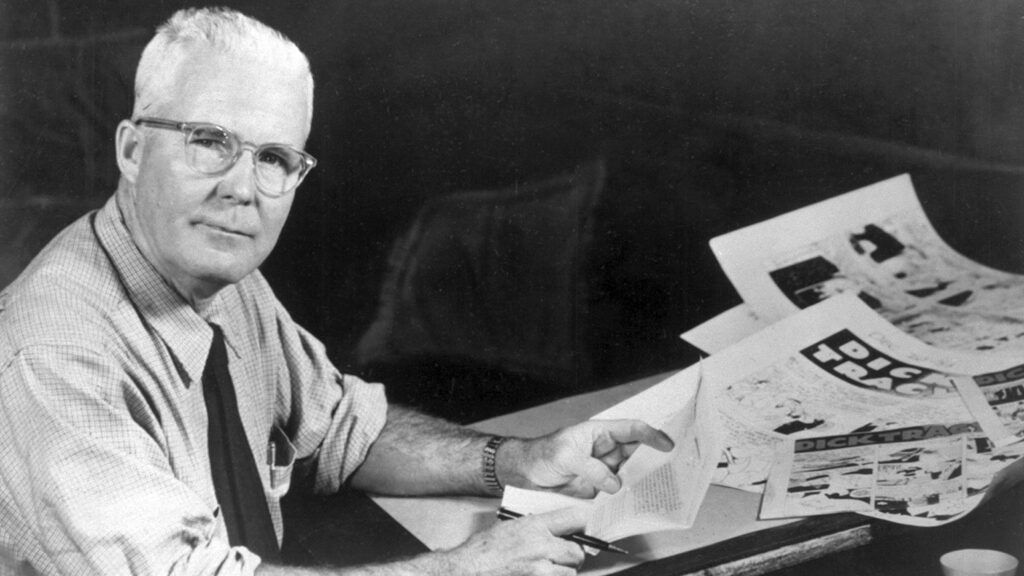Quite often friends or fans who follow my comic strip ask me how Dick Tracy came into being. To answer that, I have to go back a long way, to the days of the Depression when a frustrated and unsuccessful young cartoonist sat up late one night before his easel in his very modest home in Chicago, Illinois.
It was 1931, the Prohibition era, and organized crime in Chicago was at its height. Almost every day there were stories of gang “rides” and mob takeovers. It often seemed to me that the forces of good were powerless against this onslaught.
At that point in my life my best efforts to become a successful cartoonist seemed to be standing still. I was making a living as an ad illustrator for the Chicago Daily News. But ambitions die hard—and mine wasn’t dead by a long sight.
 On that particular evening, my wife Edna and our daughter had gone to bed. On the couch lay the daily paper where I had thrown it in disgust and frustration—its headlines screamed of another crime massacre. A spring night breeze whispered at the window, and as I sat there leaning back from the drawing board, my mind grappled with the situation.
On that particular evening, my wife Edna and our daughter had gone to bed. On the couch lay the daily paper where I had thrown it in disgust and frustration—its headlines screamed of another crime massacre. A spring night breeze whispered at the window, and as I sat there leaning back from the drawing board, my mind grappled with the situation.
Who could solve this crime problem? Sherlock Holmes certainly could, I thought. I smiled as my mind drifted back to my boyhood hero. What would he look like today? I wondered. As I thought, my hand automatically began sketching. Yes, he’d be a sharp-looking young man. Instead of a deerslayer hat, a snap-brim fedora. There. The pencil continued—the face: a firm square jaw showing determination; the aquiline nose of a searcher; now the eyes, sharp, analytical.
Suddenly there he was on paper, keen visage staring across the page. A name? Ah, being a detective, he’d be a tracer. That’s it—Plain-Clothes Tracy! Now to put him to work! As enthusiasm flooded me, my pencil sketched furiously.
I did not hear the clock strike the hours—one—two—three—as my hero came to life. There he is crawling over a rooftop on the trail of Big Boy and his gang! He leans over a skylight, trying to catch the words of the gang as they plan their next takeover. Tracy moves closer … Oh no! Crash! He falls through the skylight.
Strip after strip of daily panels seemed to fly off my easel.
As I inked in the final panel of the last strip, daylight filled the sky outside the porch window.
At breakfast I excitedly showed the strips to Edna. She studied them for a moment, then handed them back to me. “It will go.” she gasped. “You’ve got it!”
Artist friends did not agree. “You’re going too far, Gould,” they warned. “This has never been done before in comics.” Editors at the Daily News where I worked said they were “atrocious and impossible.”
I looked at them again. True, a continuing realistic adventure story had never been done before, but there was one newspaper publisher in New York who might just possibly see something in my hero. Without much hope, I packed the five strips and put them in the mail. Months went by—and I forgot about them.
My desire to be a cartoonist went far back into my childhood in Pawnee, Oklahoma, where my father worked for the Pawnee Courier Dispatch. One day he found me sketching on bits of copy paper I had fished from the newspaper’s baskets. “Chester,” he said, “there’s a county Democratic convention going on at the courthouse. How about going over there and drawing some cartoons of some of those people?”
Full of enthusiasm, I rushed over, did my work and proudly took it back to Dad who taped the sketches in the front-office window under the caption: “Convention cartoons by C. Gould.” I stood inside the window and watched the people stop, look and chuckle. “That’s what I’ll be,” I vowed. “A cartoonist!”
In later years, Dad, who thought all artists inevitably starved, suggested law as a more stable profession, and I dutifully attended Oklahoma A & M. However, I felt that I had been given a talent to entertain people with my drawings. And so, at age 21, I headed for Chicago with $50 and a bag full of cartoon ideas.
My target was Captain Joseph Medill Patterson, co-publisher of the Chicago Tribune, who had the reputation for having an uncanny knowledge of what the public wanted. Thanks to him, readers were already laughing over Gasoline Alley, The Gumps and Harold Teen.
But he wasn’t interested in what I had to offer. Undaunted, I attended Northwestern University’s night school and held minor art jobs with various Chicago newspapers and studios. In the meantime I continued to barrage Captain Patterson with ideas. There was never any response.
However, I remembered someone saying that great things are accomplished not so much by strength as by perseverance. And so I decided to keep trying.
Even when Captain Patterson moved East to publish the New York Daily News, I kept mailing him ideas. Where I got my persistence, I don’t know. Maybe it came from my grandfather, a United Brethren preacher, who rode circuit on the plains, fighting storms and blizzards. Dad, superintendent of our Sunday school, kept up the family tradition, and I remembered him saying again and again, “Don’t give up.” He’d pick up his old leather-bound Bible and read from Psalms. “The steps of a good man are ordered by the Lord, and he delighteth in His way. Though he fall, he shall not be utterly cast down, for the Lord upholdeth him with His hand.” (Psalm 37: 23-24)
Through all my failures I did have a feeling that God was there upholding me. That’s why I worked on, and why I mailed my Plain-Clothes Tracy strips to Captain Patterson in New York.
On August 13, 1931, I was working on a rug account, finishing in the details to show the rug’s fibers, when the phone rang. It was Edna.
“A wire came for you,” she said. “It’s from Captain Patterson. Do you want me to read it?”
My brain began to go numb. “Please!”
“Your Plain-Clothes Tracy has possibilities. Would like to see you when I go to Chicago next. Please call Tribune office Monday about noon for an appointment.”
Cold sweat broke out on my brow as I hung up the phone. But the following week, wearing a new suit, shoes and hat, I walked into Mr. Patterson’s office at the Tribune. An Army man, tall and erect, he was dressed with his usual informality—open shirt, coatless, scuffed Army boots.
Holding my comic strips in his hand, he paced thoughtfully around his office. I watched him closely. This was the man who had said, “We want to reach the man on the street.”
Finally he said, “ ‘Plain-Clothes’ is too long. How about a shorter word for detective, like, ‘Dick’?”
By this time I had learned that often a dispassionate outsider can improve your best ideas.
“Yes, sir,” I said.
“Okay, Dick Tracy it will be. Have two weeks of daily strips ready by the first.”
And so it began.
From the start, people predicted the strip would run out of ideas. But I found that the Lord makes each day new. He causes the seasons to change. And if we keep alive to His world by staying alert and allowing our minds to roam through its many wonderful possibilities, new ideas always come up.
One morning while driving to work from my farm in Woodstock, Illinois, I passed abandoned gravel pits that abound in this area. As I looked, I noticed a little shack in the bottom of one cavernous pit. Hansel and Gretel thoughts of my childhood rose and I chuckled. What would happen, I wondered, if one climbed down and found a witchlike creature living there?
As my mind played with the idea, a toothless old hag materialized and a name came to me—Gravel Gertie. She turned out to be a new Dick Tracy character who later married the old reprobate B.O. Plenty, and out of ugliness came their beautiful golden-haired child—Sparkle Plenty.
Today, Dick Tracy has been proving that crime does not pay for 44 years, and he is now seen by millions of readers in hundreds of newspapers around the world.
We reach a lot of youngsters and if we can simply plant in their minds that one reaps what one sows, and that good will always overcome evil, then Dick Tracy will continue doing his job.
Now, at age 75, I hope to keep working as long as the Lord allows me. Every morning at the breakfast table, Edna and I give thanks for our blessings and the chance to do what we’re supposed to do.
Dick Tracy, I’m sure, would join us in that.
For more inspiring stories, subscribe to Guideposts magazine.




